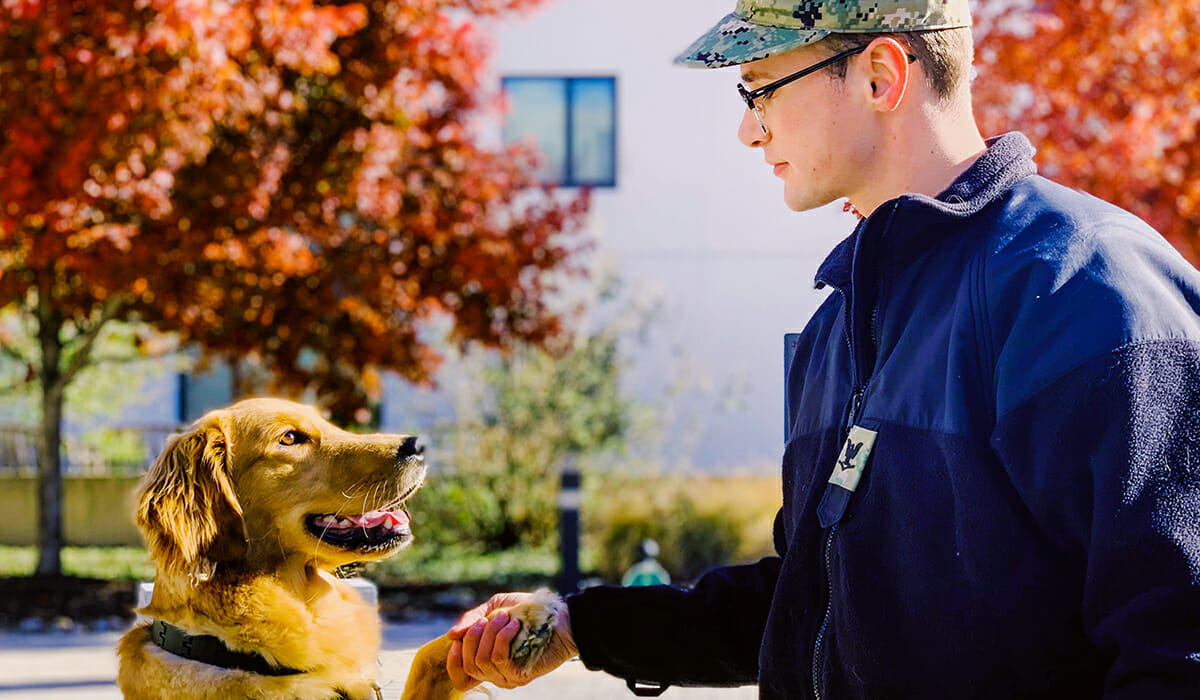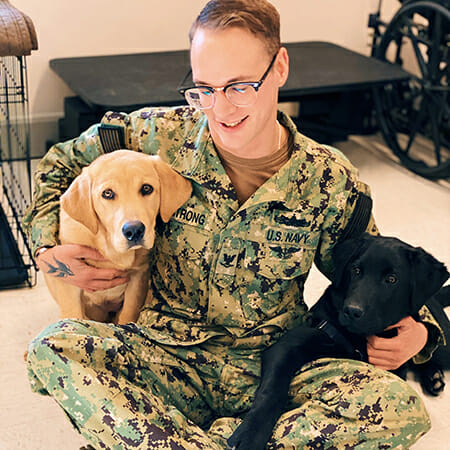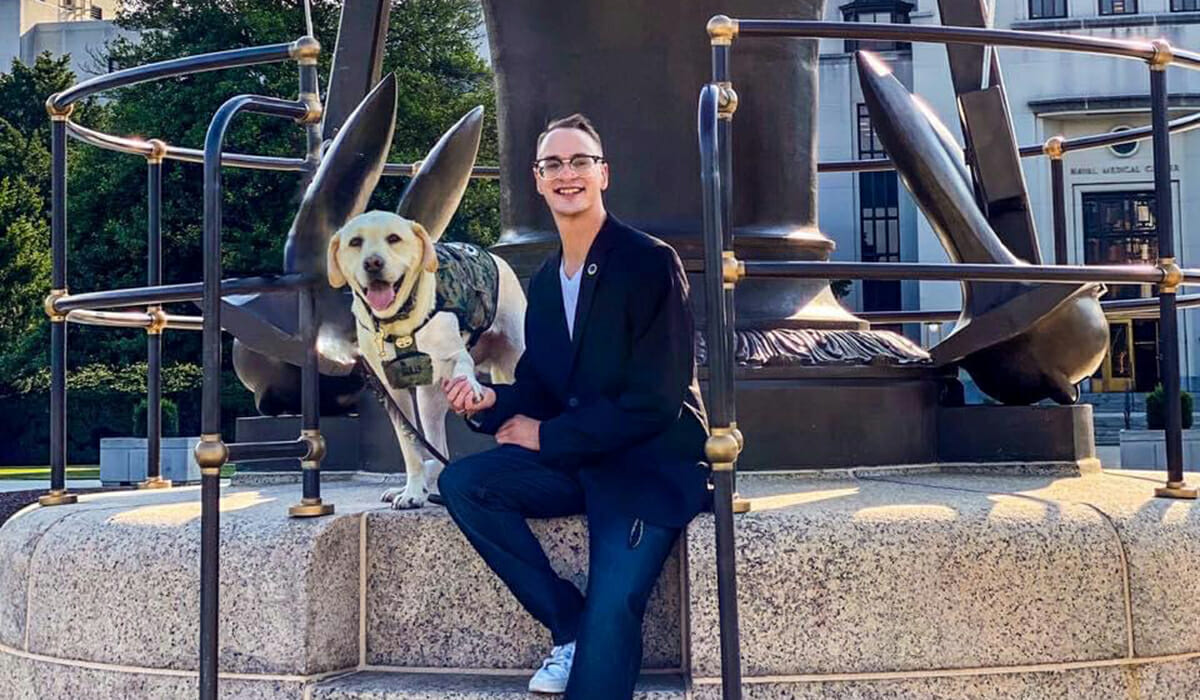Naval Officer Helps Train Service Dogs for Fellow Veterans with PTSD

Meet Daily Point of Light Award honoree Petty Officer Andrew Armstrong. Read his story and nominate an outstanding volunteer or family as a Point of Light.
Culinary Specialist Third Class (Surface Warfare/Aviation Warfare/Information Warfare) Andrew Armstrong, United States Navy, is dedicating his time to training service dogs in order to support both veterans with PTSD as well as sexual assault survivors, all with his beloved service dog-in-training Cleo by his side.
After being diagnosed with PTSD in 2018, Petty Officer Armstrong joined a medical study on PTSD and service dogs at Walter Reed National Military Medical Center, which is located on his base, Naval Support Activity Bethesda in Maryland. He enjoyed the dog training aspect of the study so much, he wanted to continue the work even after the study concluded in order to help fellow veterans struggling with PTSD. Petty Officer Armstrong is now a volunteer for Warrior Canine Connection (WCC), which enlists veterans in learning to train service dogs for fellow veterans. He trains puppies on stress cues, obedience and socialization, so they can help other veterans with PTSD just as Cleo helps him. While training, he is joined by Cleo, who was recently commissioned an Ensign in the United States Navy. She is currently on her way to obtaining her Assistant Dog International (ADI) certification in November.
In addition to his work with WCC, Petty Officer Armstrong is a volunteer for the Sexual Assault Prevention and Response Program (SAPR) on his base. He is the program’s point of contact and works to train the base’s staff and residents on sexual assault prevention and bystander intervention. He is also advocating for the program to have a facility dog or assistant animal therapy dog to support sexual assault victims. Petty Officer Armstrong is “coworkers” with President George H. W. Bush’s former service dog Sully, who is also stationed on NSA Bethesda. Sully will help out with the SAPRP during Sexual Assault Prevention Awareness Month, and also happens to be friends with Cleo.
Describe your volunteer role with Wounded Canine Connection.
Last October, I was diagnosed with PTSD. I work on the same base as Walter Reed. Walter Reed was advertising a medical study for PTSD and service dog work, and that’s how I first got started with the service dog work because I didn’t know anything about it beforehand. I ended up doing medical studies for them, but then I enjoyed the dog training aspect of it. When the medical study concluded, I went back and I would work with the dog trainers and continue training the dogs for other veterans and learning all I could, as I was going through other means to train my own service dog. I was doing my best to give back to other veterans with PTSD through WCC and learning how to train service dogs for other veterans, as well as understanding the role that a service dog has.

What made you interested in participating in the Walter Reed medical study?
I feel like PTSD is very misunderstood. In the military, there’s a big pride issue when it comes to any kind of disability or going to medical for any kind of issue, because it almost seems not macho and weak. I wanted to dispel that, and as an advocate for the sexual assault prevention program that I run on base, I’m trying to provide alternative methods for people no matter what their gender, age, rank, to come forward to get the support and help they need. Volunteering for that medical study in the first place was opening the door, then after my time ended with them as a medical study, I went back and used those trainers as mentors. Cleo would make cameo appearances, so that way I’m making sure that I’m on the right path with her to prepare for her ADI, which is Assistance Dog International qualification. It’s what the ADA [Americans with Disabilities Act] approves for military service dogs. I really liked helping out people and especially my fellow veterans with teaching them how to train their dogs, whether they have a personal dog they want to do it with. Now there’s lessons learned on my behalf that I can advocate for — how to be a good handler-dog team for a personal pet, a therapy dog or even a service dog.
Can you tell me about your work with the Sexual Assault Prevention and Response Program?
One of my collateral duties, which is a volunteer position as part of my military duties, is the Sexual Assault Prevention and Response Program point of contact. [That] means for the whole base, I’m accountable to the commanding officer for training the military police, the military housing folks, training victim advocates — that’s the military version of a crisis line, so if someone gets sexually assaulted, there’s a 24/7 cell phone that someone is trained to answer and support them through that process of getting them assistance and help. I initially volunteered to be a victim advocate on the phone, but when I went through the training it triggered my PTSD, so I had to overcome that struggle. I took a break from volunteering from that position and then I got hand selected to this position to lead the training for the base. I’m still helping out, but not in the capacity where my own baggage per se may harm another service member. Part of that job training was making sure everyone on command, whether it was staff or a resident, is being trained properly and making sure that everyone understands that it’s OK to prevent things before they happen and recognize the signs of bystander intervention.
When I first got Cleo, before I was diagnosed with PTSD, I was looking at having her volunteer with that program as the animal assistance dog. Obviously now she’s my service dog, so she can be there to support, but when I leave and I’m not active duty anymore, there will be another [spot] for another dog to fill in. I’m trying to raise awareness of how the dogs, like service dogs and facility dogs at the hospital, can provide this much more visibility and support to the victims of sexual assault. I do a lot of the advocacy work, making sure everyone is being professional and accountable. I’m pushing for that need for the program to have a facility dog or assistant animal therapy dog to support the victims as they tell their story. Part of the training we had to do was try to be desensitized by any awkward stories, whether it’s different orientations or different scenes of what could happen. It’s very awkward, so just imagine you’re already emotionally and mentally traumatized and now you’re telling a random stranger your story, how scary and difficult that could be. I feel personally it might be easier if there’s a comfort dog that’s there for you to pet, and make the focus more about the dog then on you telling the story, while you’re telling the story.
Can you describe how important having these service dogs can be for veterans with PTSD?
Everyone who has PTSD doesn’t always get it or experience it in the same way. The one common dominator for that is service dogs. Service dogs, if you are matched with one, provide you with that companionship, that medical necessity and that support. … I describe it as an imprint kind of thing. They’re always by your side. They’re always looking and watching over you. Say you are having a nightmare. They can be trained and know how to wake you up in a safe manner that’s not going to be dangerous for anyone else if they were to try to do that. I don’t work with Cleo on any PTSD tasks that could be used as a crutch for me. I don’t like big crowds, so if I go out in big crowds, I don’t teach Cleo to circle around me or to be in defense of me. I’m using her as an ability to migrate my own disability of not being able to function as if you would walking through the mall. She would assist me in that situation by laying down at my feet, nudging me if I’m showing anxious stress cues. We work a lot on stress cues, so she would nudge me out of my anxiety attacks and get me to focus on her. It’s her way of saying, “Hey, focus on me, it’s ok, we can get through this, it’s great.” It’s the same way of me using her as an excuse if I just need to leave a situation.
I view it as a very healthy alternative. I know before the service dogs were an available variation of a treatment plan for PTSD, people would just use medication or drinking. That’s not the best option obviously, but neither is different types of therapy. I’m all for therapy, I’m in therapy, but sometimes with a lot of different traumas and different personalities, it’s going to be very hard to bring up those emotions and talk through them, and be by yourself when you’re not in therapy. If you’re in therapy, you’re talking to someone, but you don’t have that 24/7 support.
Can you discuss your work with President George H. W. Bush’s former service dog Sully?
I first met him about a month before I got Cleo. He is a facility dog on base at Walter Reed. He comes and visits the patients for ceremonial visits, like for my SAPR program whenever we do SAPR month, which is a [sexual assault] prevention awareness month. He’ll come and he’ll support. He is still on task as a service dog, but not in the capacity that he had with the President. Now it’s more of an assistive therapy. I’m not his handler, I do not volunteer with the Walter Reed facility dog program, but I volunteer to reach out and work with the facility dog team in order to gain more insight and more knowledge as a support system from a handler point of view. … His handler is a very good friend of mine and Cleo and him are actually going to go hiking this weekend.

What’s been the most rewarding part of your work?
My most rewarding aspect is overcoming the training version of writer’s block when it comes to training the dogs. They don’t speak English. They don’t see and understand the way humans do. When you’re raising a kid, it’s a little bit more easy on that because they can learn a language, they can communicate without having road blocks. Whereas it really becomes difficult but when you’re trying to teach a dog a new task, and you have to meet their personality and the mental ability they have already, and build from the building blocks on how to be successful in doing that. For instance, a heel is when you get your dogs to mimic your movement on the left side of you. When you stop, they stop and sit. When you lead, they’re in perfect step. That’s something that’s very difficult for a puppy, especially a Golden Retriever like Cleo, because she stands around a lot. She’s very distracted. We can’t just try out Plan A and Plan B and [if it doesn’t work] just be like, “Oh, well, she’s untrainable.” You have to be very patient. You may have to try a couple different courses of action, but if you build up the building blocks to a foundation and be patient and follow through, once she finally gets it, it’s so rewarding. For me personally, that’s the most rewarding part, whether it’s working with the WCC dogs and getting a four- or five-month-old black lab to sit for the first time, or something more complicated like Cleo’s command heel.
What do you want people to learn from your story?
Not all disabilities are visible. If you are a part of the general public who doesn’t understand service dogs, don’t come out of the blue and try to make it harder for them and question them about their dog and the qualifications and such. We’re just trying to lead a normal life and this is how it’s going to happen for us. Also, if you’re a veteran who doesn’t necessarily know if you want a service dog or not, or think it’s a pride issue, I would just advise to take the chance and bond with a dog. It doesn’t even have to be a service dog. They have service horses and [other animals]. I just recommend dogs because I love dogs. Take care of yourself and your medical history. You did all you could for your country and you sacrificed, but now it’s time for you to reap some of that reward.
Why do you think it’s important for others to give back?
That is the question that sets America higher above most other countries. I’ve been stationed in Asia and Europe, and a lot of the communities are not as supportive of each other as America is. America is different in the aspect of — not speaking politically, but personally — as a community, we can support each other and help each other reach a common goal. [With] my American values and the way that I was raised, and as a history major in college, when I look at past presidents like George H.W. Bush to lead a life of public service and to think of someone else other than yourself — that is your sole duty whether or not you were born with privilege or you had a leg up on someone. Everyone has an American rag-to-riches story and also everyone had advantages over another person. That’s just the way the world works. If you give back and support each other in anyway you can, that is more rewarding than earning a fancy paycheck or have a million followers on Twitter or something. When you give back, it’s more rewarding, and you’re setting a good example for other people to do the same thing.
Do you want to make a difference in your community like Petty Officer Armstrong? Find local volunteer opportunities.
